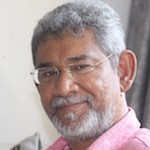May Day Thoughts: Political Economy Of The Ranil-SLPP-SLFP-UNP-SJB Convergence
By Dayan Jayatilleka –

Dr. Dayan Jayatilleka
Reports in the mainstream media give every indication of a convergence between President Wickremesinghe and the Sri Lanka Podujana Peramuna (SLPP) led by the Rajapaksas. This seems shocking given that the SLPP was born precisely in opposition to the SLFP’s disastrous alliance under the leadership of President Sirisena with Ranil Wickremesinghe in 2015.
However, a shared hatred of the Aragalaya as well as a shared perception of belonging to an Establishment electorally besieged by the leftwing JVP–NPP are the subjective factors that cemented the SLPP-Wickremesinghe convergence.
In strategic economic policy or the economic model, there is a de facto or emergent triangular convergence, which is even broader than the political convergence. Unlike the political convergence which is Ranil-SLPP-SLFP, the policy convergence includes the SJB:
(a) President Wickremesinghe and the Sri Lanka Podujana Peramuna (SLPP)
(b) The SLFP-SLPP-UNP
(c) Ranil and the SJB Economic Council
The SLPP-SLFP-Wickremesinghe convergence, which is in effect an SLFP-SLPP-UNP alliance, and the Ranil-UNP-SLPP-SLFP-SJB economic policy bloc indicates one of two things:
(a) Either the arc of the ‘1956 project’ of national (capitalist) development has ended, or
(b) The project, updated and modified, has made the transition to a different stewardship, namely the JVP-NPP.
I argue the latter.
For decades, an underlying conceptual assumption of Sri Lankan politics was that the ‘1956 project’ led by the SLFP was the project of a ‘mixed economy’ deriving from a ‘middle path’. This articulated the interests of the so-called ‘national bourgeoisie’, a wing of the capitalist class that was on the rise and had a greater propensity for manufacturing than its rival the so-called comprador or pro-imperialist bourgeoisie, represented by the UNP.
The national bourgeoisie was opposed to dependency on the West and strove for autonomous development, assisted by the socialist countries. Its hallmark was a privileging of the role of the state, though it was not a statist economy as in the USSR or China, but a ‘mixed economy’.
The comprador bourgeoisie was the faction of the capitalist class that played an intermediate role between imperialism and the local market and was the main engine of external dependency. It was also far less ‘statist’ in its economic model.
Over the decades, this conceptual demarcation became less significant as the two wings of the bourgeoisie began to merge, giving rise to the concept of ‘compradorization’ (or ‘compradorification’) of the so-called ‘national bourgeoisie’. This was understood to be the underlying factor for the rightward drift of the SLFP even during the Sirimavo Bandaranaike administration of 1970-1977, with Anura Bandaranaike as its main representative.
That trend was accelerated by the privatization program, verging on neoliberalism undertaken by the Chandrika Bandaranaike Kumaratunga presidency.
There was a welcome throwback to the ‘semi-statist’ economic model of the classic SLFP, during the Mahinda Rajapaksa presidency, but it was momentary and did not outlast his presidency.
The Yahapalanaya hybrid government of 2015 was the first formalization of the new UNP-SLFP convergence. The second formalization is now underway in 2024 between the SLFP-SLPP and the UNP’s leader.
With the currently ongoing fire-sale of state assets by the Wickremesinghe-SLPP administration, the ‘compradorization’ of the class which supported the SLFP- SLPP and therefore, the embrace of the ‘dependency’ option by the SLFP-SLPP is complete. The SLFP-SLPP no longer represents the ‘national capitalist’ and ‘semi-statist’ project of 1956 and the SLFP-SLPP. There is therefore no objective reason for the SLFP-SLPP not to embrace President Wickremesinghe.
But does this mean that the project itself is over, either because it has been completed or abandoned? No. There is a strong political party (JVP) and broader allied movement (NPP) which stands opposed to the total liquidation of the state sector of the economy that President Wickremesinghe, the SLFP-SLPP and the opposition SJB (going by its Economic Blueprint and its economic discourse) are committed to.
The 1956 project of a strong national capitalist base/foundation—NOT to confused with an exclusively national capitalism—is now being carried forward by the non-capitalist (and originally anti-capitalist) JVP, and its new partner-movement the NPP.
The UNP-SLFP-SLPP-SJB project is to raise revenue by selling-off the state sector to foreign corporates and states. ‘The national’ is absent in their economic makeup.
The JVP-NPP’s project is what Marxism calls ‘development of the forces of production’. It intends to do so by altering, modifying, but not liquidating the state sector. It hopes to de-governmentalize, i.e., de-politicize, the state sector while retaining state ownership, though not always management.
The long arc of the 1956 project of ‘mixed economy/national development’ has not ended. Abandoned by the SLFP-SLPP; eschewed by the SJB, it has been reformatted and reloaded; ‘reborn’ under new parentage of a new class or counter-elite represented by the JVP-NPP.
The post May Day Thoughts: Political Economy Of The Ranil-SLPP-SLFP-UNP-SJB Convergence appeared first on Colombo Telegraph.



